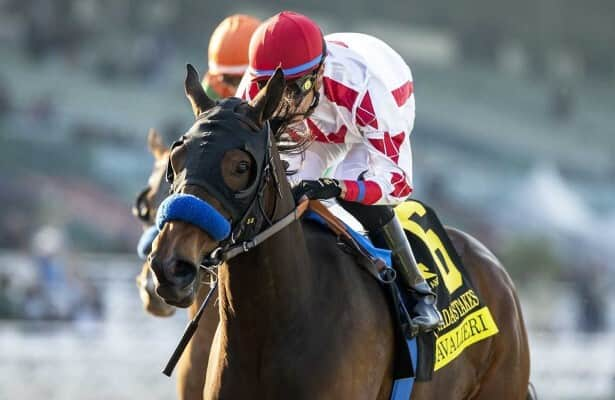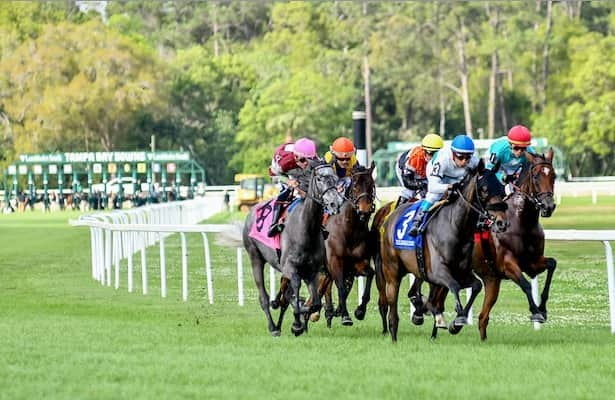Fall horse races come to fairgrounds

Pleasanton has flirted in the past with horse racing outside of the normal summer fair dates.

And there have always been thoughts about what it might be like to have racing throughout the year at the iconic Pleasanton track, the oldest one-mile dirt track in the United States.
This Saturday (Oct. 19), the chance to be a year-round racing facility gets real, as the inaugural Golden State Racing meet kicks off its 26-day fall meet at the Alameda County Fairgrounds.
“It’s an exciting time,” said Allen Aldrich, a longtime horse owner who was raised in Pleasanton. He is a very influential figure in California horse racing and was instrumental in bringing Golden State Racing to town.
The race meet is set Fridays to Sundays through Dec. 15.
That the race meet is even happening was a surprise to many and was certainly thought of as a long shot by more than a few people.

It all came together quickly after 1st Racing — a division of The Stronach Group (TSG) — finally made good in June on one of their threats that they were closing Golden Gate Fields in June.
The closing of Bay Meadows in 2008 left Golden Gate Fields as the lone year-round racetrack in the northern half of the state, and with that came the feeling of entitlement to whatever they wanted.
That was shown when TSG decided to consolidate all their operations in Southern California where they own Santa Anita Park and San Luis Rey Downs training center.
Their plan was simple: bring an end to live racing in Northern California, giving TSG a monopoly on horse racing in the state.
But instead of caving, the organizations in the north said, not so fast, and discussions about what could happen moved to what needs to happen and happen quickly.
The California Authority of Racing Fairs, the Northern California Fairs, and the horsemen of the area all came together and put together a plan.
That was the genesis of Golden State Racing.
“From the start, (TSG’s) plan was to close down racing in Northern California for the so-called benefit of the south,” said Larry Swartzlander, the executive director of CARF. “There was never any hesitation. The fairs are expanding to include GGF dates and push hard for improving the race quality in the north but work with the south.”
The first thing was to determine which venue would be used.
“We started not knowing where we would race,” Aldrich explained. “We asked Santa Rosa (they have an existing turf course), then Sacramento — (Pleasanton) was the last man standing.”
The biggest player in Golden State Racing is the Alameda County Fair. If they don’t buy-in 100%, it doesn’t happen. Jerome Hoban is the CEO of the Alameda County Fair and a big supporter of horse racing, which has been the key.
Hoban laid out the beginning of the Pleasanton plan.
“In March it was determined that it was too expensive, too much time, and there were contractual conflicts to take year-round racing to Cal Expo in Sacramento. That’s when the planning and logistic started,” Hoban said.
The first step was to procure more stalls. With Golden Gate Fields shutting down, horses needed to find homes. The facility in Pleasanton brought in more, increasing to around 1,000 stalls.
With the horses, trainers and the trainers’ teams taken care of, the bid was launched to get the Golden Gate Fields dates. Of course, TSG thought it would be easy to end NorCal racing.
What they didn’t factor was everyone coming together so quickly and unified to save racing in the northern half of California.

“The northern horsemen are totally unified,” Swartzlander said.
“The biggest plus is the horsemen are all together,” Aldrich added. “They want to do whatever it takes to make it work.”
The man charged with filling the races — Tom Doutrich, the racing secretary for both CARF and Golden State Racing — is blown away by everyone coming together so rapidly.
“This is the most unified I have seen it in my 30 years of being in the industry,” Doutrich said.
The unity, which is extremely rare in the horse racing world, seemed to hit home to the California Horse Racing Board.
After a contentious four-hour meeting in March, the CHRB awarded the 2024 fall racing dates previously held by Golden Gate Fields to Golden State Racing by a 6-0 vote.
Recently the 2025 dates for the first half of the year were also awarded to GSR, thus setting up racing in Pleasanton from Oct. 19 through the Alameda County Fair in 2025.
“The CHRB board recognizes the importance of breeding and successful racing in the north in order to maintain racing in California,” Swartzlander said.
Which brings us to Saturday and the opening day. Aside from a pair of short fall dates, Pleasanton has not had racing following the annual summer fair, and certainly has not had to run through the winter.
As far as the track itself is concerned, it will be fine, thanks in large part to track master Steve Woods. The track will be winterized, and Pleasanton won’t miss a beat in inclement weather.
The racing fans may be another thing.
“Racing is an all-weather sport,” Hoban said. “Our facility in Pleasanton is not weatherized and hosting crowds comfortably in the winter will be a challenge for customers. We do have a reasonably great climate all year long.”

Doutrich knows at times it will be a challenge.
“People won’t be coming to the races in shorts and flip-flops, but we’ll get by,” Doutrich said.
There is the climate-controlled Sky Lounge that will be open every day, with seats available for purchase.
Aldrich also pointed out there will be the use of existing facilities.
“You’ve got the Farmhouse right next door,” he said of the attractively designed restaurant that is open during the fair. “We will bring in wagering machines and we have the TVs in there.”
Everyone agrees what the key will be for a successful first race meet.
“We need to fill races and establish the Golden State Racing brand as a recognizable nationwide premier racing entity,” Hoban said.
And to fill fields, you need horses to run.
“We expect near 1,000 horses in October,” Swartzlander said. “We thought that if we still had 700 horses it would be fine. Our goals are to raise purses, attract out of state horsemen and increase commissions.”
Doutrich has seen the willingness to all work together in the north a huge boost.
“This is the best time for racing in Northern California,” Doutrich said. “The horsemen have come together and are engaging. You need a product that everyone wants to bet.”
There is a purse structure of an average of $170,000 a day, which was the last agreement set in place. By comparison, Golden Gate Fields was offering a purse structure of $119,167 at the end of their time.
A big financial hurdle is the building of a turf course at Pleasanton. It is universally agreed that the turf course will be needed for long-term success.
“Already in process,” Swartzwelder said of the turf course. “It will be completed by mid-2026.”

Hoban is optimistic but was also more measured.
“Fundraising and an economic model needs to pan out to justify a turf track,” Hoban said. “It is definitely on our horizon and anticipated but the horse population will ultimately help make the determination of when.”
With everything coming together to get the race meet started, one of the obvious keys to success is getting people to the track regularly.
The Alameda County Fair excels in marketing and has rolled their success during the fair into setting up promotions for the race meet.
“We have a great team and have created promotions that will help bring new fans to the track,” said Wyatt Didericksen, the racing operations manager for the Alameda County Fairgrounds. “Opening day we have Octoberfest!”
There is also a Wine Fest on Saturday for Nov. 2, the second day of Breeders’ Cup racing. The Trackside Terrace — a popular destination during the fair — is back, as is the Sky Lounge.
The Fan Cave, so popular during past fall meets in Pleasanton, is back again on the second level, allowing race fans to keep up with football games and other televised sporting events.
Sundays will feature $5 beers and hot dogs, something that fits nicely with the Fan Cave.
What’s the future look like to all the parties as GSR heads into its initial weekend? In one year? In five years?
“We hope to be a smooth-running machine in one year, with an established brand and remain the oldest one-mile dirt track in the nation,” Hoban said, enthusiastically.

Didericksen echoed Hoban’s feelings.
“One year from now, we are back running with a larger barn area and an established brand name,” Didericksen said. “We hope to continue being an iconic facility that introduces new fans to our industry as well as letting those that love the sport continue to enjoy it here in Northern California.”
“In one year, we will know if the program will succeed,” Swartzlander said. “In five years, we will most likely be racing with Del Mar with The Stronach Group likely gone.”
Aldrich sees the possibility of a true Northern California circuit.
“I could see three-to-four-month boutique meets,” said Aldrich. “Run in Santa Rosa for one, then Sacramento, and in Pleasanton. The horsemen are more comfortable shipping their horses around Northern California.”
At the end of the day, Golden State Racing will need the support not only of the Northern California horsemen, but the greater Pleasanton and Bay Area communities.
Hoban sees that coming to fruition.
“We have a long history of racing and a very supportive community and surrounding region,” Hoban said.
One area to be affected by the racing dates is the Pleasanton Golf Center, located on the inside of the racetrack. There will be no golfing on Fridays to Sundays, with tee times limited to Mondays through Thursdays.
Monday times are available from 7 a.m. to dark, with Tuesdays to Thursdays having times from 10:30 a.m. to dark.
It’s uncharted waters for horse racing in Pleasanton, but Aldrich is optimistic.
“We don’t know what we don’t know,” Aldrich said. “We have plenty of events planned. The unity is something I have never seen up here, and we are in it for all the right reasons.”
Related
Leading Parx jockey Sanchez will serve 7-day suspension
Photo: Jason Moran / Eclipse Sportswire Jockey Mychel Sanchez will serve a seven-day suspension and pay an additional $1,750 in fines
Bill Mott talks about plans for Sovereignty, Just F Y…
Photo: Gulfstream Park / Lauren King Sovereignty, dramatic late-running winner of the Fountain of Youth (G2) March 1, is being pointed
Up-and-coming Cavalieri chases Grade 1 glory in Beholder Mile
Photo: Santa Anita / Benoit Photo Cavalieri and Alpha Bella, who finished one-two in the Grade 3 La Cañada in January at Santa Anita,
4 stakes showcase shipping stars on Tampa Bay undercard
Photo: Gonzalo Anteliz Jr. / Eclipse Sportswire The stars will shine Saturday at Tampa Bay Downs, and not just in the Grade 3 Tampa Ba











